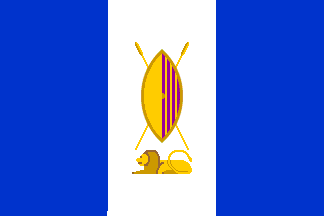
Last modified: 2022-10-22 by bruce berry
Keywords: buganda | uganda |
Links: FOTW homepage |
search |
disclaimer and copyright |
write us |
mirrors
 image
by Miles Li, 09 Jan 2016
image
by Miles Li, 09 Jan 2016Buganda is the largest traditional kingdom within Uganda (the others are
Toro, Ankole and Bunyoro, which make up part of the Western Region). During
the colonial period, the British allowed the Kabaka (king) of Buganda and
the rulers of the other states a large degree of power and influence, and
this was retained a little while into independence. The kingdoms were abolished
by Milton Obote in the 1960's but have recently been revived by President Yuseveni's government
as a way of bringing government closer to the traditional feelings of the
people.
Roy Stilling, 14 September 1996
When Uganda became independent, Milton Obote became prime minister. Being from the small Langi tribe, he appointed King 'Freddy' Mutesa II, Kabaka of Buganda, as president of Uganda. As has been mentioned, the Baganda were the largest ethnic group and more anglicized (by contact with missionaries and the colonial authorities) than the other groups.
By appointing Mutesa, Obote miscalculated. He alienated other tribes
and didn't actually succeed in placating the Baganda, who by May 1966 were
openly agitating for Obote's overthrow. Obote used the then deputy commander
of the Army, one Idi Amin to do the
dirty work. Amin personally attacked the Kabaka's palace with a 122 mm
gun mounted on his (Amin's) personal jeep. The King escaped and fled to Britain were he died in (I think) the early 1970s. Later,
of course, Idi Amin staged a coup against Obote. Ironically, this was initially
welcomed by the Baganda (naturally, Amin blamed Obote for their persecution).
Stuart Notholt, 15 September 1996
![[Buganda 1861-81 flag]](../images/u/ug_bug1.gif) image
by Jaume Ollé, from his
site
image
by Jaume Ollé, from his
site
![[Buganda 1881-89 flag]](../images/u/ug_bug2.gif) image
by Jaume Ollé, from his
site
image
by Jaume Ollé, from his
site
![[Buganda 1884-86, 1889 flag]](../images/u/ug_bug4.gif) image
by Jaume Ollé, from his
site
image
by Jaume Ollé, from his
site
![[Buganda 1891 flag]](../images/u/ug_bug3.gif) image
by Jaume Ollé, from his
site
image
by Jaume Ollé, from his
site
![[Buganda 1892]](../images/u/ug_1892.gif) image
by Jaume Ollé
image
by Jaume Ollé
I have been reading Thomas Pakenham's "The Scramble for Africa"
(London: Abacus, 1992) which includes the following interesting reference:
Chapter 23, p. 422 : Frederick Lugard, on arriving in Kampala in 1892, found the
King of Buganda flying "an enormous home-made flag, two lances and a shield on a
red ground". One is tempted to suppose that the red ground had been suggested by
the red flag of the Zanzibari traders, frequently
mentioned by Pakenham. There is a reference to "The Diaries of Lord Lugard",
Vol. 3, p. 31, ed. by Margery Perham (4 vols., 1959-63).
Kenneth Fraser, 03 Mar 2011
![[Buganda 1892 royal standard]](../images/u/ug-ro-92.gif) image
by Jaume Ollé
image
by Jaume Ollé